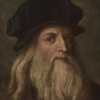Leonardo da Vinci

Leonardo da Vinci
Leonardo di ser Piero da Vinci, more commonly Leonardo da Vinci or simply Leonardoˈvintʃi] ; 15 April 1452 – 2 May 1519), was an Italian polymath whose areas of interest included invention, painting, sculpting, architecture, science, music, mathematics, engineering, literature, anatomy, geology, astronomy, botany, writing, history, and cartography. He has been variously called the father of paleontology, ichnology, and architecture, and is widely considered one of the greatest painters of all time. Sometimes credited with the inventions of the parachute, helicopter and tank,...
NationalityItalian
ProfessionPainter
Date of Birth15 April 1452
CityVinci, Italy
CountryItaly
Experience does not ever err; it is only your judgment that errs in promising itself results which are not caused by your experiments
The organ of perception acts more readily than judgment.
Experience never errs; it is only your judgments that err by promising themselves effects such as are not caused by your experiments.
Experience never misleads; what you are misled by is only your judgment, and this misleads you by anticipating results from experience of a kind that is not produced by your experiments.
No member needs so great a number of muscles as the tongue; this exceeds all the rest in the number of its movements
There shall be wings! If the accomplishment be not for me, 'tis for some other.
The most praiseworthy form of painting is one that most resembles what it imitates.
Nothing can be love or hated unless it is first known.
Obstacles cannot crush me; every obstacle yields to stern resolve.
When once you have tasted flight, you will forever walk the earth with your eyes turned skyward, for there you have been, and there you will always long to return.
The painter who is familiar with the nature of the sinews, muscles, and tendons, will know very well, in giving movement to a limb, how many and which sinews cause it; and which muscle, by swelling, causes the contraction of that sinew; and which sinews, expanded into the thinnest cartilage, surround and support the said muscle.
The mind of the painter must resemble a mirror, which always takes the colour of the object it reflects and is completely occupied by the images of as many objects as are in front of it.
Our body is dependant on Heaven and Heaven on the Spirit.
As a well-spent day brings happy sleep, so a life well spent brings happy death.